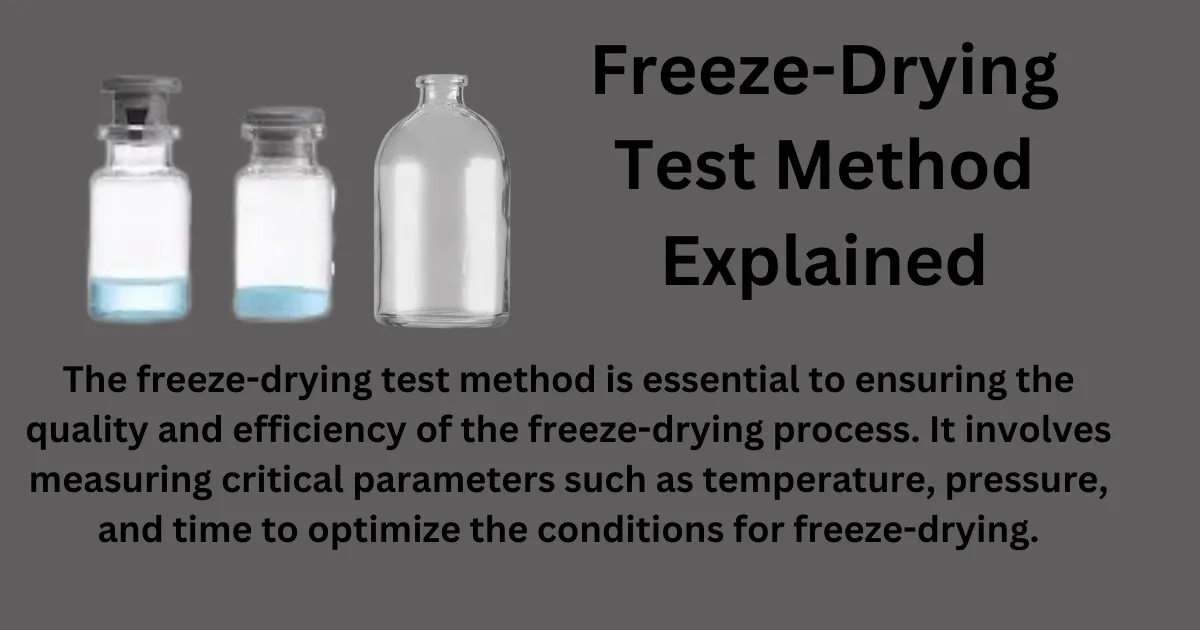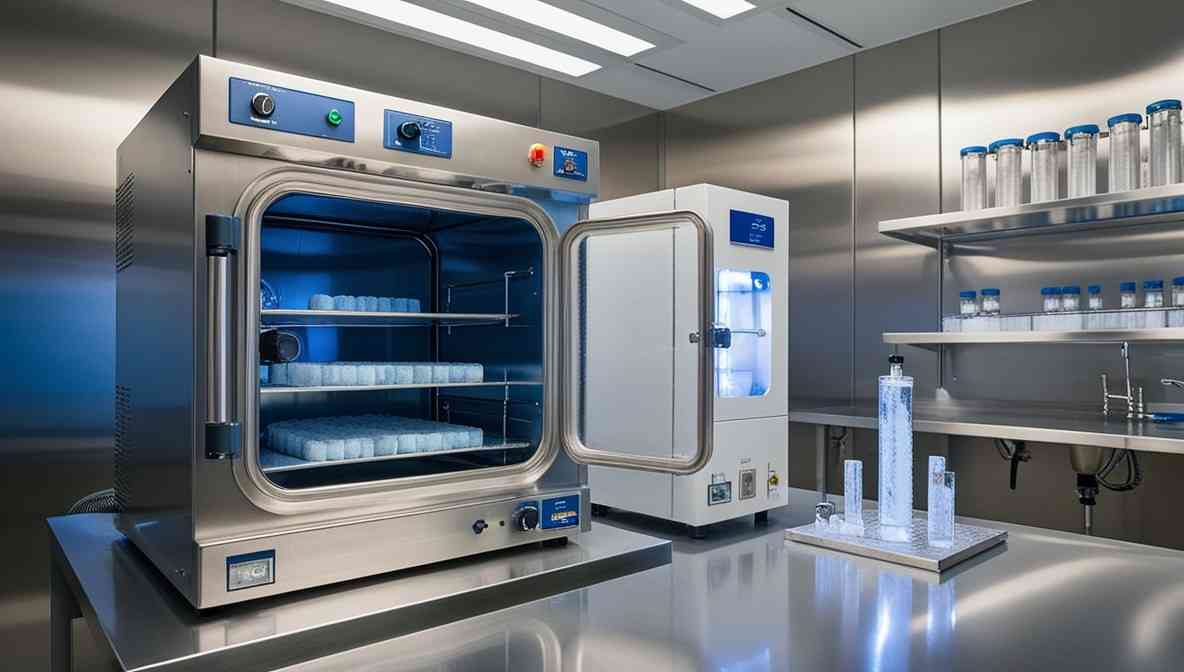Freeze-Drying Test Method As explained, freeze-drying, also known as lyophilization, is a crucial process used in various industries, including pharmaceuticals, food preservation, and biotechnology. This method involves removing water from a product after it has been frozen, ensuring the stability and longevity of the product. In this article, we’ll dive into the freeze-drying test method, exploring its conditions, equipment, and key parameters.
What is Freeze-Drying?
The process involves freezing the product, lowering pressure, and then removing the ice by sublimation. This technique helps in maintaining the product’s structure and nutritional value.
Historically, freeze-drying has been used since World War II to preserve blood plasma and penicillin. Today, it’s widely applied in pharmaceuticals, where preserving the integrity of a product is paramount.
Freeze-Drying Test Method
The freeze-drying test method is essential to ensuring the quality and efficiency of the freeze-drying process. It involves measuring critical parameters such as temperature, pressure, and time to optimize the conditions for freeze-drying.
Freeze-Drying Conditions
For successful freeze-drying, maintaining ideal conditions is crucial. The environment needs to be carefully controlled to ensure the product’s stability. This includes precise temperature and pressure settings.
Equipment Used in Freeze-Drying
Various types of freeze dryers are used, depending on the scale and requirements of the process. uses advanced freeze dryers equipped with state-of-the-art technology to ensure optimal performance.
Control System
The control system is the heart of the freeze-drying process. software used in the system plays a vital role in monitoring and maintaining the conditions within the freeze dryer. The software ensures that the temperature, pressure, and other parameters are kept within the desired range.
Pressure Regulation
Regulating pressure is a critical aspect of the freeze-drying process. Nitrogen (N2) is often used to maintain the pressure. Nitrogen 5.0, known for its high purity and low water content, is ideal for this purpose.
Specifications of Nitrogen 5.0
- Chemical Symbol: N2 (Nitrogen)
- Purity: More than (NMT) 99.996%
- Oxygen Content: Less than (NLT) 2 to 3 ppm
- Water Content: Less than (NLT) 5 to 6 ppm
- Other Impurities: Less than NLT 0.2 to 2.5 ppm
Product Containers
The choice of product containers is essential in the freeze-drying process. Vials of different sizes, such as 2ml, 5ml, 8ml, 10ml, 50ml, and 100ml, are used depending on the product’s requirements. The size of the container can impact the efficiency and effectiveness of the drying process.
Filled Volume: Standard filled volumes for the vials are typically 3ml, 4ml, 5 ml, and 25 ml The volume must be carefully measured to ensure consistency and quality during freeze-drying.
Number of Vials per Shelf: The design of the freezer determines the number of vials per shelf. Common configurations include 40, 50, and 60 vials per shelf. The arrangement must be optimized to ensure even drying.
Number of Shelves Used: The number of shelves used in the freeze dryer can vary from 1 to 5 or more. The configuration affects the overall drying efficiency and the capacity of the freeze dryer.
Pressure Rise Measurement (PRM)
Pressure Rise Measurement (PRM) is a technique used to assess the integrity of the freeze-drying process. By monitoring the pressure changes, it’s possible to detect leaks and ensure that the process is proceeding as expected.
Regulating Pressure During Drying
Maintaining a consistent pressure of 5.0 is crucial during the drying phase. Nitrogen is used to achieve this, ensuring that the product dries evenly and efficiently.
Technical Data of Nitrogen 5.0
Nitrogen 5.0 is chosen for its superior quality, ensuring that the freeze-drying process is not compromised by impurities. Its high purity levels make it ideal for maintaining the necessary conditions.
Preparation of Freeze Drying
The preparation phase involves filling the vials, which can be done using an automatic filling machine or manually. Once filled, the vials are placed on trays, and stoppers are set. This preparation is crucial to ensuring that the product is ready for the freeze-drying process.
Steps involved in freeze-drying test method
Loading step: After starting the freeze dryer, the loading temperature is achieved, then the freeze dryer door is opened on the aseptic area side, and the empty and filled vial is loaded into the freeze dryer with the help of ALUS (automatic loading and unloading system).
The freezing cycle is started by SCADA (Supervisory Control and Data Acquisition) systems. Which are used for controlling and monitoring the freeze-drying process or
Loading stage: Once the freeze dryer is started and the loading temperature is reached, the door is opened in a sterile area. Empty and filled vials are then loaded into the freeze dryer before initiating the freezing cycle using SCADA.
Freezing: A material changes from a liquid to a solid state during freezing. This transition occurs when the liquid’s molecules slow down enough to be arranged into a solid form with definite places by their attraction forces.
Primary Drying (Sublimation): Pressure is lowered, and heat is added to allow the ice to sublimate directly into vapor. During the primary drying phase, water vapor adheres to and solidifies on the cold condenser surface, protecting the vacuum pump from moisture. Approximately 95% of the material’s water content is removed during this slow process.
Secondary Drying (Desorption): Remaining moisture is removed by further lowering pressure and raising temperature. or Water desorption from the cake starts in the same spot as primary freeze-drying is finished and all ice has been removed via sublimation. The primary drying phase begins when this stage, called secondary drying, begins.
Venting and stoppering of vials: After completing the secondary drying process, vials are fully stoppering in the freeze dryer using the stoppering force applied by the shelf. venting the chamber with nitrogen 5.0 Stoppering the vials inside the freeze dryer in nitrogen atmosphere
Unloading stage: after completion of freeze drying and stoppering stage, reach the unloading temperature, open the door on aseptic area side, and unload the freeze drying product.
Conclusion
The freeze-drying test method is a sophisticated process that requires careful attention to detail. From maintaining ideal conditions to using high-quality nitrogen, every step is crucial to ensuring the product’s integrity and stability. By understanding and optimizing these parameters, industries can achieve efficient and effective freeze-drying.
FAQs
What is the main purpose of freeze-drying?
The main purpose of freeze-drying is to preserve perishable materials by removing water content while maintaining their structure and nutritional value.
Why is nitrogen used in the freeze-drying process?
Nitrogen is used to regulate pressure and maintain an ideal environment, ensuring efficient and effective drying.
What are the typical sizes of vials used in freeze-drying?
Typical vial sizes include 2 ml, 5 ml, 8 ml, 10 ml, 50 ml, and 100 ml, depending on the product’s requirements.
What is Pressure Rise Measurement (PRM)?
PRM is a technique used to monitor the integrity of the freeze-drying process by measuring pressure changes.
How is the preparation for freeze-drying done?
Preparation involves filling vials with the product, placing them on trays, and setting stoppers to ensure they are ready for the freeze-drying process.

